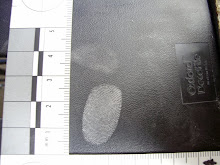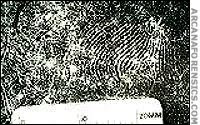 This is known as the Lindbergh kidnapping of 1932. Where someone wrote 14 ransom notes to a family. When the police got a hold on these letters they had no trouble identifying them as all the same person, but had a great deal of trouble identifying the culprit: Richard Bruno Hauptmann. They figured out the kidnapper's identity by using techniques that Albert Osborn discovered in 1910. Osborn recognized the significance of handwriting analysis, and he devised a means and techniques for matching them. Many of the techniques still used today. The technique used to determine the culprit in this case was to look for the differences. Anyone can look at the similarities with a fair amount of accuracy but to look at the differences, especially the ones that matter, is not hard and often requires years of training and practice. Handwriting changes over they years. Also, each time you write a word, it will look different (at least some parts will). The letter's will change depending on where they are placed in the word/sentence. The trick is, the one that Osborn discovered, is what letters don't change; better yet, what parts of the word/letter don't change.
This is known as the Lindbergh kidnapping of 1932. Where someone wrote 14 ransom notes to a family. When the police got a hold on these letters they had no trouble identifying them as all the same person, but had a great deal of trouble identifying the culprit: Richard Bruno Hauptmann. They figured out the kidnapper's identity by using techniques that Albert Osborn discovered in 1910. Osborn recognized the significance of handwriting analysis, and he devised a means and techniques for matching them. Many of the techniques still used today. The technique used to determine the culprit in this case was to look for the differences. Anyone can look at the similarities with a fair amount of accuracy but to look at the differences, especially the ones that matter, is not hard and often requires years of training and practice. Handwriting changes over they years. Also, each time you write a word, it will look different (at least some parts will). The letter's will change depending on where they are placed in the word/sentence. The trick is, the one that Osborn discovered, is what letters don't change; better yet, what parts of the word/letter don't change.Another important thing to remember is that you have to distinguish between style characteristics and individual characteristics. Forensic Scientists want to examine the individual characteristics. Things like the sizes of the letters: width, height; the curves of the letters, the slants. Also if the letters are "slurred" together or connect. How close the words are together, or how close the letters are to other letters, the pressure put on the pencil on down strokes, upward strokes. Also the placement on the line is important. Example: if the letters on one line are so tall that they intersect with letters on the line above it. The margin left over is important as well.
These are just a few techniques that are used in identifying the author of an unknown document. To develop the skills required to work in this field would take dedication, and years of training. Even with years of practice, the validity of handwriting analysis may be iffy in court. Handwritten documents would go into the questioned documents folder. From there analysts will analyze it and come to a conclusion.
These are pictures that of a forging assignment that we did in class where the top is the original, the middle is a free hand forge and the last is a trace forgery.
 This is the origional:
This is the origional: This is the freehand forge:
This is the freehand forge:
This is an example of a traced forge:

The above is a check which Andy correctly identifyed as me. I wrote it. then tore it up. He then put it back together and taped it and then correctly identifyed it as me.
 ***The latter of the pictures was taken courtesy of A. Platt. Thank you.
***The latter of the pictures was taken courtesy of A. Platt. Thank you.

 And Imbricate:
And Imbricate:







 The above picture is of a blood typing kit we did in class
The above picture is of a blood typing kit we did in class



 Kooladria:
Kooladria: Mr. Kelly:
Mr. Kelly:





